Period of the american literature
by Alexandra Betancourt

1. realism and naturalism (1870) (1910)
1.1. The human cost of the Civil War in the United States was immense: more than 2.3 million soldiers fought in the war, and perhaps up to 851,000 people died in 1861-65. Walt Whitman stated that "great literature... emerged from the era of those four years," and what emerged in the following decades was a literature that presented a detailed view and unadorned in the world as it truly was.
1.2. This was the essence of realism. Naturalism was an intensified form of realism. After the grim realities of a devastating war, they became the writers' main mode of expression.
1.3. Samuel Clemens was a typecary, a journalist, a riverboat captain and a traveling worker before becoming , in 1863 at the age of 27, at Mark Twain. He first used that name while reporting on politics in the Snowy Territory. He then appeared in the short story "The Celebrated Jumping Frog of Calaveras County", published in 1865, which catapulted him to national fame. Twain's story was a humorous story, but his characters were realistic depictions of real Americans. Twain deployed this combination of humor and realism throughout his writing.
2. Naturalism, like realism, was a literary movement inspired by 19th-century French authors who sought to document, through fiction, the reality they saw around them, particularly among the working and middle classes who lived in the cities. Theodore Dreiser was the first among American writers to embrace naturalism.
3. the work of sister carrie Carrie (1900) is the most important American naturalistic novel. Henry James shared the opinion of realists and naturalists that literature should present reality, but his style of writing and use of literary form also sought to create an aesthetic experience, not simply to document the truth. He was concerned about the value clash between the United States and Europe. His writing shows characteristics of both 19th century realism and naturalism and 20th century modernism.


